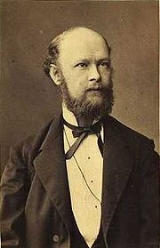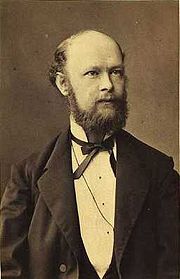
Karl Verner
Encyclopedia

Copenhagen
Copenhagen is the capital and largest city of Denmark, with an urban population of 1,199,224 and a metropolitan population of 1,930,260 . With the completion of the transnational Øresund Bridge in 2000, Copenhagen has become the centre of the increasingly integrating Øresund Region...
) was a Danish
Denmark
Denmark is a Scandinavian country in Northern Europe. The countries of Denmark and Greenland, as well as the Faroe Islands, constitute the Kingdom of Denmark . It is the southernmost of the Nordic countries, southwest of Sweden and south of Norway, and bordered to the south by Germany. Denmark...
linguist
Linguistics
Linguistics is the scientific study of human language. Linguistics can be broadly broken into three categories or subfields of study: language form, language meaning, and language in context....
. He is remembered today for Verner's law
Verner's law
Verner's law, stated by Karl Verner in 1875, describes a historical sound change in the Proto-Germanic language whereby voiceless fricatives *f, *þ, *s, *h, *hʷ, when immediately following an unstressed syllable in the same word, underwent voicing and became respectively the fricatives *b, *d, *z,...
, which he discovered in 1875.
Verner, whose interest in languages was stimulated by reading about the work of Rasmus Christian Rask
Rasmus Christian Rask
Rasmus Rask was a Danish scholar and philologist.-Biography:...
, began his university studies in 1864. He studied Oriental, Germanic
Germanic languages
The Germanic languages constitute a sub-branch of the Indo-European language family. The common ancestor of all of the languages in this branch is called Proto-Germanic , which was spoken in approximately the mid-1st millennium BC in Iron Age northern Europe...
and Slavic languages
Slavic languages
The Slavic languages , a group of closely related languages of the Slavic peoples and a subgroup of Indo-European languages, have speakers in most of Eastern Europe, in much of the Balkans, in parts of Central Europe, and in the northern part of Asia.-Branches:Scholars traditionally divide Slavic...
, and then served in the army before resuming his studies. He travelled to Russia
Russia
Russia or , officially known as both Russia and the Russian Federation , is a country in northern Eurasia. It is a federal semi-presidential republic, comprising 83 federal subjects...
in December 1871, spending nearly a year learning the language. His first scientific paper was Nogle Raskiana (1874).
At the same time he began to study the accent of Danish
Danish language
Danish is a North Germanic language spoken by around six million people, principally in the country of Denmark. It is also spoken by 50,000 Germans of Danish ethnicity in the northern parts of Schleswig-Holstein, Germany, where it holds the status of minority language...
and the Slavic languages. According to his own account, upon getting up one morning, he was puzzled by the question why the Gothic
Gothic language
Gothic is an extinct Germanic language that was spoken by the Goths. It is known primarily from the Codex Argenteus, a 6th-century copy of a 4th-century Bible translation, and is the only East Germanic language with a sizable Text corpus...
words fadar and broþar have different consonant
Consonant
In articulatory phonetics, a consonant is a speech sound that is articulated with complete or partial closure of the vocal tract. Examples are , pronounced with the lips; , pronounced with the front of the tongue; , pronounced with the back of the tongue; , pronounced in the throat; and ,...
s after the root vowel
Vowel
In phonetics, a vowel is a sound in spoken language, such as English ah! or oh! , pronounced with an open vocal tract so that there is no build-up of air pressure at any point above the glottis. This contrasts with consonants, such as English sh! , where there is a constriction or closure at some...
. Since he was preoccupied with the study of accent at the time, he sought the explanation in that direction. This led to the formation of Verner's Law. He finished the relevant paper and sent it to Vilhelm Thomsen
Vilhelm Thomsen
Vilhelm Ludwig Peter Thomsen was a Danish linguist. In 1893, he deciphered the Turkish Orkhon inscriptions in advance of his rival, Wilhelm Radloff...
in 1875. Urged by Thomsen, he published it a year later.
Despite his achievement, Verner considered himself only an amateur of German philology. He declined certain offers of professorship, contenting himself to be a librarian at Halle
Halle, Saxony-Anhalt
Halle is the largest city in the German state of Saxony-Anhalt. It is also called Halle an der Saale in order to distinguish it from the town of Halle in North Rhine-Westphalia...
. With reluctance, he applied for the Bopp
Franz Bopp
Franz Bopp was a German linguist known for extensive comparative work on Indo-European languages.-Biography:...
prize, which went to him in 1877. He became an extraordinary professor only in 1888, when he was also elected a member of the Royal Danish Academy of Sciences and Letters
Royal Danish Academy of Sciences and Letters
Royal Danish Academy of Sciences and Letters is a Danish non-governmental science Academy, founded 13 November 1742 by permission of the King Christian VI, as a historical Collegium Antiquitatum...
.
External links
- Daniel Kilham Dodge's review of Verner Dahlerup's Nekrolog over Karl Verner, American Journal of PhilologyAmerican Journal of PhilologyThe American Journal of Philology is a quarterly academic journal established in 1880 by the classical scholar Basil Lanneau Gildersleeve, published by the Johns Hopkins University Press. It covers the field of philology, and related areas of classical literature, linguistics, history, philosophy,...
, The Johns Hopkins University Press, 1897. Available through JSTORJSTORJSTOR is an online system for archiving academic journals, founded in 1995. It provides its member institutions full-text searches of digitized back issues of several hundred well-known journals, dating back to 1665 in the case of the Philosophical Transactions of the Royal Society...
.

